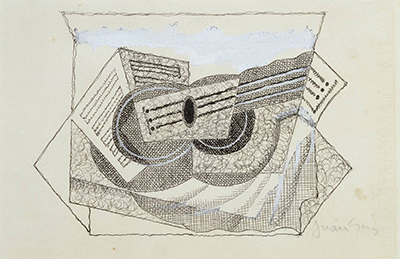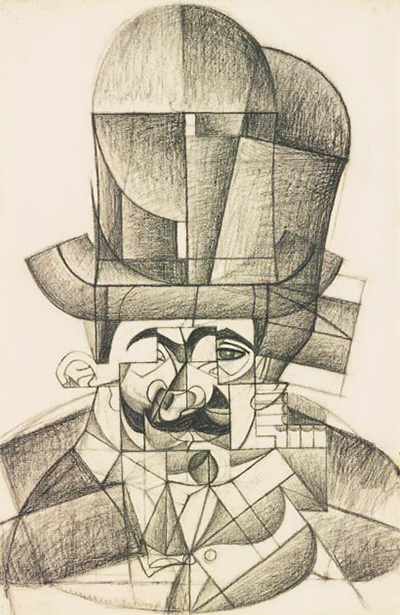Without his natural ability to draw, Juan Gris may never have received the opportunity to study art. It was this skill which initially drew attention to his potential and started him on the long path towards the success that he ultimately would eventually achieve.
Illustration, due to its relative simplicity, has played an important role in the early years of many a famous artist. The likes of Warhol and Lichtenstein would produce magazine pieces in order to make an early living as they sought to forge a path in their new career. Gris was no different in this regard, producing drawing and caricatures in order to supplement his income and allow him to at least have financial security whilst working on his own ideas out of office hours. The photograph included to the left is of the drawing titled Man with Opera Hat, that artist Gris produced in 1912. He completed the piece in black chalk and it was reported that a huge number of amendments are visible if you look at the original closely enough, which backs up the belief that his typical drawing process contained a large element of trial and error.
The cubist approach taken by Gris and the other artists with whom he spent time socially was complex and could not be achieved in single flourish of the pencil or brush. Considerable planning was required in order to move from reality to the final construction of the cubist portrait and this is where the study drawings could play such a valuable role in preparing for a later painting. Gris' own talent for this discipline also aided his ability to make artistic decisions prior to commencing the actual final work in oils. To adjust at that stage would be far harder and more time consuming. In fact, the final artwork might even struggle to recover if errors were made whilst applying oils and the overall piece might have to be abandoned completely, such is the organic and random nature of art production.
It has taken a fair amount of time to research even just the information on the artist's drawings that we have included in this section. In the cases of most famous painters and sculptors from the past, their work in this genre is documented particularly well. This is despite the fact that this art form would be the basis to most of their work and was probably part of the first artistic techniques that they learnt at a young age. Daniel-Henry Kahnweiler has been the best source for information about the artist's career, with him being his main dealer as well as a close friend for many years. There was also another notable art dealer, Curt Valentin, who was based over in the US and he constructed several catalogues of the artist's work and even some scrapbooks of miscellaneous items. The majority of publications about his work have drawn on these sources, to varying levels. The inclusion of Juan Gris' drawings within these documents is normally done so from the perspective of understanding his development processes, with study sketches accompanying final, complete oil paintings. Seldom few would be included purely for their artistic value alone, as independant artworks.
Within the realms of art history the Spanish have always placed less importance on the drawing qualities of a successful painter, as compared to most in France. Diego Velazquez, for example, was particularly unusual in that he worked tirelessly on his skills as a draughtsman, encouraged by his father. Gris, however, felt French in his heart, and even preferred his friends to refer to him as "Jean". Within his new home nation there is always a suspicion of any painter who cannot impress with the pencil or chalk in the early stage of each artwork. It is as if he is an imposter. Spanish academics have always been a little more relaxed and willing to judge a painter on his paintings alone. Thus his insistence of endless practice of this art form might underline how much Juan had emotionally committed to France and this transition got stronger the longer he remained in the country.
 One significant drawing from Juan Gris that we were able to uncover from the archives was Guitar and Music Book from 1923. This artwork is owned by the Tate in the UK and for that reason has been examined and researched in more depth than most of the artist's other work in this discipline. Whilst the content is nothing new for the cubists, with them all having made use of guitars in their work at some point or another, this piece is significant because it was this year that Gris started to produce pen and ink artworks for the very first time - at least from the perspective of his time as a professional artist. A closer examination of that artwork reveals a selection of different sketching techniques which together produce a detailed, cubist guitar. There are circular squiggles, gradiented lines and also grids in different densities, with other regions of the composition left entirely blank. As with most of his sketches, the artist signs it in the bottom right hand side.
One significant drawing from Juan Gris that we were able to uncover from the archives was Guitar and Music Book from 1923. This artwork is owned by the Tate in the UK and for that reason has been examined and researched in more depth than most of the artist's other work in this discipline. Whilst the content is nothing new for the cubists, with them all having made use of guitars in their work at some point or another, this piece is significant because it was this year that Gris started to produce pen and ink artworks for the very first time - at least from the perspective of his time as a professional artist. A closer examination of that artwork reveals a selection of different sketching techniques which together produce a detailed, cubist guitar. There are circular squiggles, gradiented lines and also grids in different densities, with other regions of the composition left entirely blank. As with most of his sketches, the artist signs it in the bottom right hand side.




